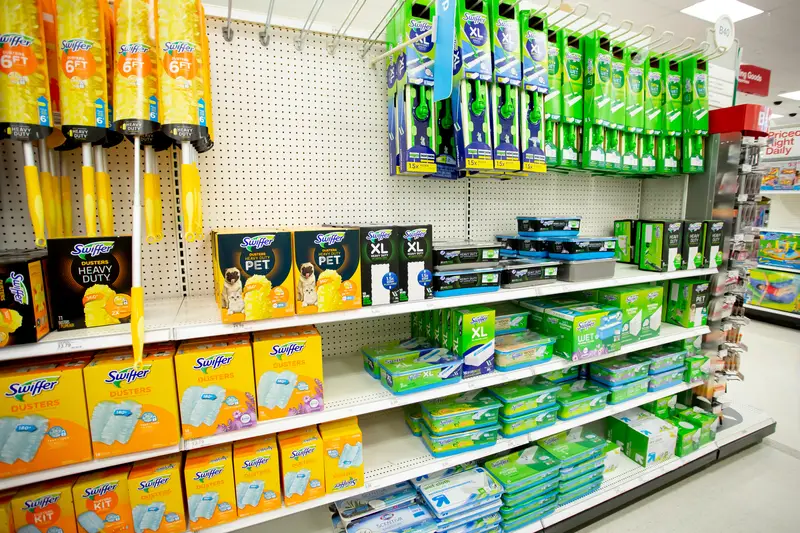That convenient cleaning tool sitting in your closet might be doing more harm than good. While Swiffer products have revolutionized home cleaning with their ease of use, mounting evidence suggests these popular cleaning tools could be contributing to various health issues. From respiratory problems to skin irritation, the hidden costs of this cleaning convenience might surprise you.
Hidden chemicals lurking in your Swiffer products
The convenience of Swiffer products comes at a potentially significant cost to your health. These cleaning tools contain several concerning chemicals, including 2-butoxyethanol and quaternary ammonium compounds, which have been associated with various health issues. These chemicals aren’t just sitting quietly in your cleaning supplies – they’re actively released into your home environment every time you use the product.
Regular exposure to these chemicals can lead to skin irritation and respiratory problems. The quaternary ammonium compounds, in particular, have raised red flags in the scientific community due to their potential links to more serious health conditions. While manufacturers maintain these products are safe when used as directed, research suggests that even low-level exposure over time could have cumulative effects.
The impact of these chemicals becomes more concerning in poorly ventilated spaces. When used indoors without adequate air circulation, the concentration of these compounds can build up, potentially increasing their negative effects. This is particularly problematic during winter months when windows typically remain closed, or in apartments where ventilation options are limited.
Studies have shown that repeated exposure to cleaning product chemicals can sensitize individuals over time, meaning they become more reactive to these substances with continued use. This explains why some people who initially had no issues with these products may develop sensitivities or reactions after prolonged use.
Your indoor air quality takes a hit
The impact of Swiffer products on indoor air quality is more significant than many realize. Recent research has identified hundreds of volatile organic compounds (VOCs) released by cleaning products, including those found in Swiffer solutions. These compounds don’t simply disappear after use – they can linger in your indoor air for hours or even days.
The synthetic fragrances added to many Swiffer products contribute to this air quality issue. These fragrances aren’t just pleasant scents – they’re complex chemical mixtures that can trigger respiratory problems, headaches, and other health issues. The problem becomes more pronounced in smaller spaces or areas with limited ventilation, where these compounds can accumulate to potentially harmful levels.
Indoor air pollution from cleaning products can be particularly problematic because we spend so much time inside our homes. The Environmental Protection Agency estimates that Americans spend approximately 90% of their time indoors, making the quality of indoor air crucial to our overall health. The continuous use of chemical-laden cleaning products can create a persistent source of indoor air contamination.
Children and pets are especially vulnerable to these air quality issues. Their smaller bodies and faster respiratory rates mean they take in more air relative to their body size, potentially increasing their exposure to these airborne chemicals. Additionally, children and pets spend more time close to the floor, where recently cleaned surfaces may still be off-gassing chemicals.
Microplastic particles become airborne during use
An often-overlooked hazard of Swiffer products is their contribution to indoor microplastic pollution. The synthetic materials used in Swiffer pads and dusters can break down during use, releasing tiny plastic particles into your home environment. These microscopic pieces of plastic can become airborne and may be inhaled or settle on surfaces throughout your home.
The problem compounds with regular use. Each time you sweep or dust with a Swiffer product, you’re not just cleaning – you’re potentially creating a cloud of invisible plastic particles. These microplastics can accumulate in your home over time, particularly in carpets, upholstery, and other textiles, making them difficult to completely remove even with thorough cleaning.
Research into the health effects of microplastic exposure is ongoing, but early studies suggest cause for concern. These particles are so small they can be inhaled deep into the lungs or absorbed through skin contact. Once in the body, they may cause inflammation and potentially carry other harmful chemicals that adhere to their surface.
The environmental impact extends beyond your home. When you dispose of used Swiffer products or wash them down drains, these microplastics enter our water systems. They contribute to the growing global problem of plastic pollution, affecting ecosystems and potentially entering our food chain through contaminated water and soil.
The false sense of clean masks deeper problems
While Swiffer products might leave surfaces appearing clean, they can actually mask underlying hygiene issues. The disposable pads may pick up visible dust and dirt, but they often fail to address deeper cleaning needs. This superficial cleaning can give users a false sense of security about the cleanliness of their living space.
The electrostatic action of Swiffer products, while effective at attracting dust, doesn’t actually eliminate many common household allergens. Studies have shown that various indoor allergens require more thorough cleaning methods for effective removal. Simply passing a Swiffer over surfaces may temporarily improve appearance without addressing these underlying health concerns.
This inadequate cleaning becomes particularly problematic in homes with allergy sufferers or individuals with respiratory conditions. The belief that regular Swiffer use is providing adequate cleaning may prevent people from implementing more effective cleaning strategies that could better address their health needs.
Additionally, the fragrance in many Swiffer products can mask odors that might otherwise alert you to problems like mold or mildew. These underlying issues can continue to grow and affect your health while remaining undetected due to the masking effects of cleaning product fragrances.
Impact on beneficial household bacteria
Modern science has revealed the importance of maintaining a healthy balance of microorganisms in our environment. The chemicals in Swiffer products, particularly their antimicrobial components, don’t discriminate between harmful and beneficial bacteria. This indiscriminate elimination of microorganisms can disrupt the natural bacterial balance in your home.
Research has shown that exposure to a diverse range of environmental microbes helps develop and maintain a healthy immune system. Over-sanitizing our living spaces with chemical cleaners may contribute to what’s known as the “hygiene hypothesis” – the idea that excessive cleanliness might lead to increased allergies and autoimmune conditions.
The disruption of beneficial bacteria extends beyond surface-level cleaning. When these chemicals become airborne or are tracked through the house, they can affect the microbial communities in various parts of your home. This disruption might impact everything from your skin microbiome to your respiratory health.
The long-term consequences of regularly eliminating beneficial bacteria from our environment are still being studied. However, emerging research suggests that maintaining a diverse microbial environment might be crucial for optimal health, particularly for developing immune systems in children.
Skin absorption of cleaning chemicals
Your skin is not just a barrier – it’s a permeable organ capable of absorbing substances it comes into contact with. The chemicals in Swiffer products can be absorbed through your skin during use, especially when handling wet pads or when the cleaning solution makes direct contact with your skin. This absorption route provides another way for potentially harmful substances to enter your body.
The risk of skin absorption increases with repeated exposure. Regular use of these cleaning products, particularly without protective gloves, allows these chemicals to accumulate in your system over time. Some of the compounds found in cleaning products have been shown to pass through the skin barrier more easily than others.
Heat and moisture can increase the skin’s permeability to these chemicals. When you clean with Swiffer products in warm or humid conditions, or if you’re sweating while cleaning, your skin may absorb more of these substances. This effect is particularly concerning in bathrooms or during summer months when these conditions are more common.
The cumulative effect of this chemical absorption through the skin can lead to various health issues. Some people may develop contact dermatitis or other skin conditions, while others might experience systemic effects as these chemicals enter their bloodstream through dermal absorption.
Respiratory system exposure during cleaning
Every time you use a Swiffer product, you’re potentially inhaling a mixture of chemicals and particles. The act of sweeping or dusting can stir up not just visible dust but also microscopic particles that become airborne. These particles, combined with the chemical compounds in the cleaning solutions, create a concerning respiratory exposure scenario.
The risk becomes more significant in enclosed spaces. When cleaning in smaller rooms or areas with poor ventilation, the concentration of airborne chemicals and particles can reach higher levels. This increased concentration means your respiratory system is exposed to a more concentrated mixture of potentially harmful substances.
Regular exposure to these airborne substances can lead to both immediate and long-term respiratory issues. Some people might experience immediate symptoms like coughing, wheezing, or shortness of breath, while others might develop sensitivities or chronic respiratory problems over time with repeated exposure.
The combination of chemical vapors and stirred-up particles can be particularly problematic for people with existing respiratory conditions. Those with asthma, allergies, or other respiratory sensitivities may find their conditions exacerbated by regular use of these cleaning products.
Understanding the potential health impacts of Swiffer products is crucial for making informed decisions about your cleaning routine. While these products offer convenience, the associated health risks cannot be ignored. Consider switching to natural cleaning alternatives like vinegar solutions, baking soda, or reusable microfiber cloths. These options not only protect your health but also contribute to a more sustainable environment. Remember, a truly clean home shouldn’t come at the cost of your well-being.

